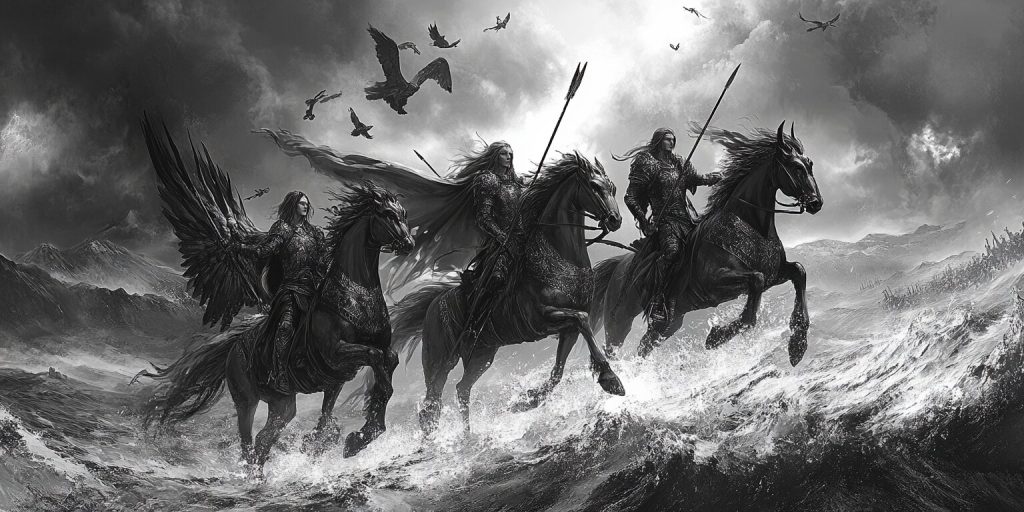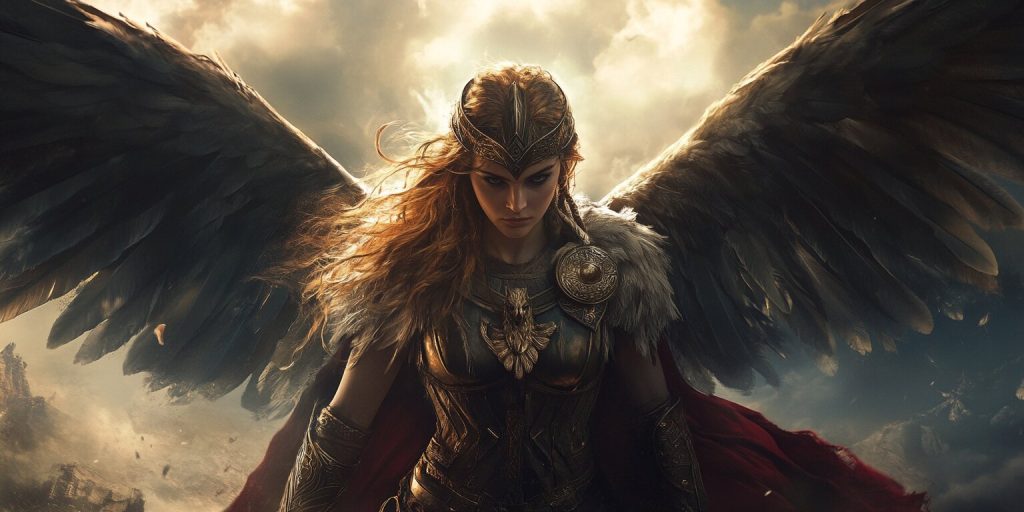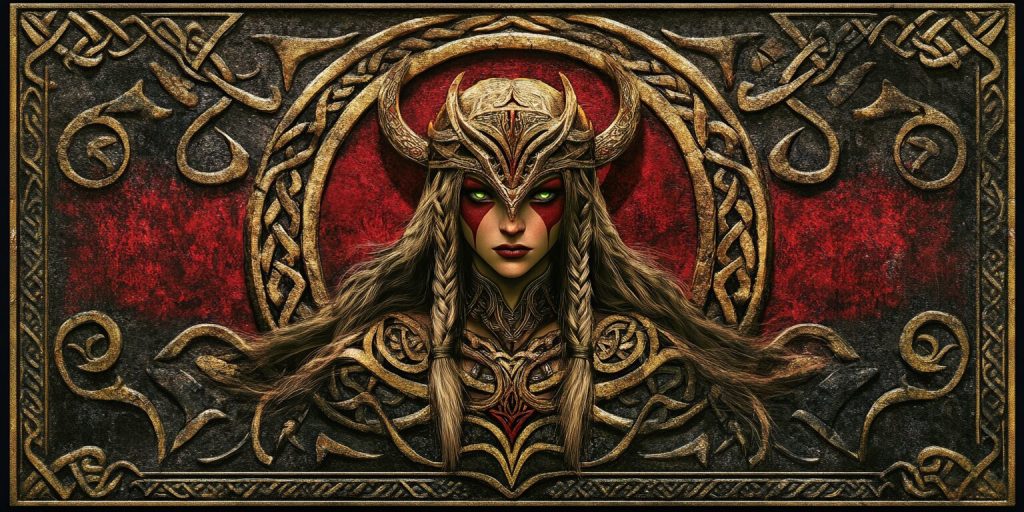Aegishjalmur (Helm of Awe), Freya, Mjölnir (Thor’s Hammer), Norse Goddesses, Norse Runes, Norse Symbols, Valknut, Valkyries, Vanir Goddesses, Yggdrasil (World Tree)
Female Viking Symbols: Norse Emblems of Strength and Courage
Viking culture is full of symbols that show female strength and courage. These symbols are important for women in Norse mythology and society, demonstrating the big role women played.
Women in Norse mythology were known for their bravery and caring natures. They were important for their communities and families, which shows the power of female symbols in Viking culture.
We will look into symbols that show female power. These symbols help us understand the Viking warrior spirit.
Introduction to Norse Symbols
Norse symbols were key to Viking culture and its stories. They were not just for show; they had deep meanings. These symbols showed who someone was and what they stood for in their community.
Symbols were used in rituals, art, and daily life. You could find them on weapons, jewelry, and even stones with ancient writings. Symbols like the Valknut and Mjölnir showed how Vikings mixed faith with their daily lives. These symbols stood for strength, bravery, and connection to something greater.
Learning about these symbols helps us better understand Norse culture. It shows us the depth of a society that left a lasting mark. By looking into the history of these symbols, we see how they helped the Norse people feel united and strong.
Understanding the Divine Feminine in Norse Culture
The divine feminine is a big part of Norse culture. It shaped how women lived in Viking society. Women did more than stay at home. They worked in farming and trade and even fought in battles.
Their work shows women’s strength and resilience. They used symbols of female strength that still echo today.
The Role of Women in Viking Society
In a society led by men, Viking women made their mark. They cared for the home, worked in fields, and helped keep the community going. They could own land and start divorces, showing they had a lot of freedom.
This shows how Viking women were strong in their way. They went beyond what was expected of them.
Mythological Figures Representing Female Strength
Norse myths tell us about strong women like the Valkyries. These female warriors chose who would live or die in battle, demonstrating their bravery and the power of women.
The Valkyries show how much respect women received in Norse culture. Their stories mix myth with reality, demonstrating women’s value. They celebrate the divine feminine and women’s strength in stories and history.

Female Viking Symbols: Emblems of Courage
Female Viking symbols were very important in Norse culture. They were symbols of courage. They showed the strength of women in a society known for its warriors.
These symbols inspired Viking women. They showed their beliefs and the wisdom of their ancestors. Here are some symbols of courage:
- The Valknut: This symbol was linked to the afterlife. It showed bravery in facing death. It was a symbol of courage for women who chose to be warriors.
- Wolf and Raven Imagery: These animals were connected to hunting and war and were often depicted in Viking symbols. They stood for strength and were symbols of the Viking spirit.
- Goddess Symbols: Symbols of Freya, the goddess of love and war, reminded women of their power. They showed that women could be strong and compassionate at the same time.
These symbols meant a lot to Viking families and communities. They connected people to a legacy of strength, and because of these symbols, women were inspired to be warriors and leaders.
Common Symbols Associated with Valkyries
In Norse mythology, the Valkyries are strong protectors who show strength and leadership. Symbols like the Valknut and Mjölnir are key in Viking culture. They show the important role of women in the Viking Age and the balance of life and death.
The Valknut and its Significance
The Valknut symbol has three interlocking triangles, a vector of strength and unity. It shows the link between life and death, reminding us of the Valkyries guiding warriors to Valhalla. The symbol shows the mix of fate and death, highlighting women’s strength in Viking society.
Mjölnir: Thor’s Hammer as a Symbol of Protection
Mjölnir, or Thor’s Hammer, is a symbol of protection. It is Thor’s powerful weapon, showing strength and safety. Valkyries, as warrior maidens, were linked to Mjölnir, which shows female power and protection. In Norse mythology, these symbols show women’s bravery and care for their people.
The Importance of Runes in Viking Culture
Runes were very important in Viking culture. They were used as a written language to connect with the mystical world. The Elder Futhark, the oldest runic script, had 24 symbols. Each symbol had its own meaning and magical powers, often representing the strength of the Valkyrie.
Magic in runes was key in Norse life. They were used for divination, rituals, and as charms. People believed runes could give strength and guidance. They used these symbols in important times for power and protection.
The Elder Futhark has three groups called “aettir.” Each group has symbols for different themes like strength, fertility, and life and death. For example, Uruz means strength, and Fehu implies wealth. These symbols helped Vikings understand their roles and dreams.
Runes were also a way to send messages. They were carved on stones, wood, and weapons. These messages showed who people were and what they valued. Today, we still learn a lot from Viking runes. This helps us better understand their beliefs and history.
Norse Symbols of Strength: Helm of Awe and Yggdrasil
The Helm of Awe and Yggdrasil are key symbols in Viking mythology. They show strength and how everything is connected. They are important for understanding life and being fearless.
Helm of Awe: Symbol of Fearlessness
The Helm of Awe, or Ægishjálmr, was a powerful symbol for warriors, often regarded as a Viking symbol of strength. It made the wearer fearless, feeling unbeatable in battle. The Helm’s design has special runes that create a magical aura.
This aura helped warriors face challenges with confidence. The Helm shows bravery and the strength to overcome life’s obstacles.
Yggdrasil: The World Tree and its Connection to Life and Death
Yggdrasil is the world tree in Norse stories. It shows the cycle of life and death. This huge ash tree links all worlds, showing how life, death, and rebirth are connected.

Every part of Yggdrasil represents the bond between gods, humans, and creatures. It teaches us about the power of unity and the ongoing cycle of life.
Female Viking Symbols Found in Jewelry
Jewelry was a key way for Viking women to show who they were and their strength. Symbols of feminine strength in their jewelry showed their bravery, toughness, and important societal roles. These pieces were made carefully, linking them to their heritage and culture.
Strength Jewelry among Viking Women
Viking women wore jewelry that showed their strength. Symbols like the Valknut and Owls were common. They meant strength and wisdom. These symbols were more than just decorations; they were charms for protection and power.
Wearing this jewelry allowed Viking women to share their beliefs and values. It linked their strength to their group’s identity.
Modern Interpretations of Viking Jewelry
Today, modern jewelry takes inspiration from Viking times, featuring symbols and meanings from that era. Designers mix old symbols with new styles. Now, you can find jewelry like bracelets, necklaces, and rings with Norse symbols for today’s fashion.
This new jewelry keeps Viking culture alive. It connects people today with their Norwegian roots, showing that Viking symbols of strength and femininity remain relevant.
The Role of Freya in Norse Mythology
Freya is a key figure in Norse mythology, known for her roles in war and love. She is a goddess of fertility and beauty and a fierce warrior. This shows how Viking culture valued both feminine strength and bravery.
Freya, as a Goddess of War and Love
Freya is seen as a goddess of both war and love. Viking warriors looked to her for help in battle, believing she could bring them victory. But she’s also linked to love and fertility, showing Norse society’s importance of relationships.

Freya’s Symbols and Their Meanings
Freya’s symbols reflect her many qualities. The necklace Brísingamen stands for beauty, love, and femininity. Other symbols include:
- Falcon Feather Cloak: It means transformation and moving between worlds.
- Freya’s Chariot: With two cats, it shows her link to home and family, contrasting with her warrior side.
- Boar: It’s a sign of fertility and strength, highlighting her roles in love and war.
These symbols show how Freya represents women’s strength. They remind us of the mix of love and power in Norse goddess stories.
Viking Combat and Symbols of Warrior Spirit
Viking combat and warrior symbols are key parts of their lore. Symbols like the raven show bravery, wisdom, and strength, vital for both men and women warriors.
The raven symbol is special. It means guidance and change on the battlefield. It shows how women warriors were seen as brave, not just men.
The Symbolism of Raven in Viking Lore
Ravens were very important in Viking stories. They were seen as messengers from the gods. When they showed up, they told us about the battle’s outcome.
They were linked to Odin, who used them for wisdom and strategy. This made ravens a sign of spiritual connection for warriors.
Fierce Warriors: Women on the Battlefield
Women warriors changed how people saw strength. They participated in raids and battles, often leading alongside men. These shieldmaidens showed great courage and skill.
Their stories show Viking combat was diverse. They valued strength in everyone, not just men.
The Legacy of Viking Symbols in Today’s Culture
Viking symbols still shape our culture today. They have moved beyond their old meanings, finding new life in our modern world. People now see them as divine feminine woman symbols of strength and courage.
Viking symbols are everywhere in movies, TV shows, and books. They bring stories to life with themes of bravery and heroism, showing how symbols link the past and present.
- Nordic designs are now in fashion, jewelry, and tattoos, showing their lasting impact.
- Museums and exhibits on Viking culture share their deep symbolism with people worldwide.
- Online groups talk about Norse mythology and the modern importance of these Viking and Norse symbols.
Viking symbols prove their lasting power and appeal. These symbols help people connect with their heritage and show who they are.
Conclusion
Exploring female Viking symbols reveals their deep meaning in Norse culture. They are symbols of strength and courage. The Valkyries and jewelry designs show the bravery of women often ignored in history.
Myths about Freya show how women in Viking times were strong in war and love. These symbols tell us about women’s roles and values in Viking society and show us still important virtues today.
Understanding female Viking symbols helps us see women’s significant impact on Norse culture. Their stories inspire us today, showing that strength and courage exist for everyone, regardless of time or place.

